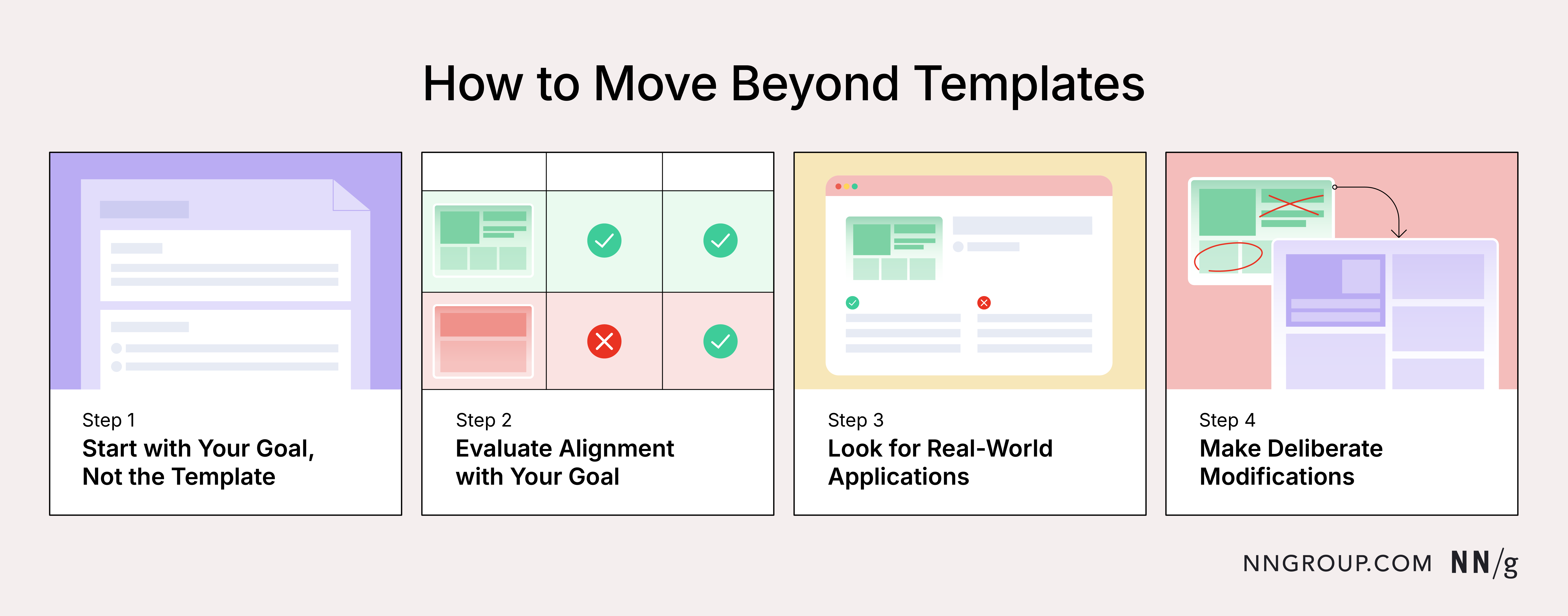Summary:
Overreliance on frameworks as universal solutions rather than adaptable starting points undermines critical thinking and threatens our field’s intellectual rigor.
The Template Trap
In our field of experience design, we’re witnessing a concerning trend: an overreliance on templates, frameworks, and “ultimate” checklists. Every day, a new “ultimate UX toolkit” or “complete design-system template” circulates across platforms like LinkedIn. With UX’s explosive international growth and the rise of social media, we’re falling into the template trap — the mistaken belief that downloading the latest framework or checklist will solve all our design challenges.
Consider design thinking as an example. When applied thoughtfully, with the right context, to the right situation, and with appropriate expectations, it’s incredibly valuable. But as it grew in popularity, people began promising that simply following its steps would revolutionize everything — and (of course), it didn’t deliver on those inflated promises.
Templates and frameworks have evolved beyond their intended purpose as starting points and are increasingly treated as universal solutions — complete answers to complex design challenges.
It’s troubling to see new practitioners adopt these tools without question, bypassing the critical thinking necessary to adapt them to their unique contexts and goals. These resources are never meant to be rigid solutions but rather flexible starting points that practitioners should modify based on their specific needs.
The Irony Is Not Lost
This observation comes from a team that regularly creates and shares UX frameworks and templates, as part of our work. At NNGroup, our mission to make complex research and design work approachable, especially for people learning or refining new skills.
The problem isn’t templates — it’s how they’re used. When we publish a journey-map template or a heuristic-evaluation framework, we do so with detailed guidance about when, why, and how to use it. We expect practitioners to bring their expertise and critical thinking to the process, adapting our starting points to meet their unique strategic needs, whether influencing higher-level business decisions or refining smaller implementation details in a feature.
The true value of a template is not in its initial form but in how it’s thoughtfully transformed to address specific contexts. That transformation process is where much of the learning and value creation happens — and it’s precisely what’s lost in the rush to implement “plug-and-play” UX solutions.
The template trap is amplified by social media, where we see a constant race to share content primarily for engagement. What’s particularly concerning is that most people resharing these frameworks aren’t their creators — they’re simply passing along templates stripped of their original context, research, and intended application.
The “UX-influencer culture” primarily targets newer professionals who might not have enough experience to approach these tools critically and who are under pressure to demonstrate value quickly in a fast-paced industry. Their solution is to turn to decontextualized templates and linear development processes popularized on social media — many removed from their original purpose and nuance required for meaningful design. The deliverables based on these templates are often polished but lack originality, personal insight, and the depth that comes from iteration, reflection, and exploring alternative directions.
Why the Template Trap Matters
UX is inherently messy, ambiguous, and heavily contextual. UX work resists being neatly packaged or approached with a one-size-fits-all mindset. When you rely too heavily on templates, you face significant risks:
- Force-fitting solutions onto unique problems
- Sacrificing solutions that require intellectual rigor and deep understanding
- Missing the contextual nuances that make each design challenge unique
- Developing a false sense of competence without building fundamental understanding
- Collectively lowering the bar for what constitutes professional UX work
Moving Beyond Template Dependency
So, how do you move beyond the template trap to thoughtful adaptation, especially if you are newer to the field? Let’s break this down into concrete steps.

1. Start with Your Goal, Not the Template
Before you even search for a template or checklist, clearly articulate your goal. What problem are you trying to solve? What outcome do you want to achieve? This sounds obvious, but we often see teams grab a journey-mapping template before they’ve defined what they want to learn from the journey-mapping exercise.
2. Evaluate Alignment with Your Goal
Assess if the template or framework aligns with your goal. For example, if you’re trying to understand the emotional state of your users during a specific task, an empathy map might be more valuable than an experience map. Don’t force a mismatched tool just because it’s trending on LinkedIn.
3. Look for Real-World Applications
Seek out shared examples or case studies of where the template was created and succeeded. Look for practitioners sharing their actual experiences — what worked, what failed, what they modified, and why. These detailed accounts, often found on platforms like Medium or in conference talks, provide the context and nuance that’s typically stripped away when templates are shared on social media.
4. Make Deliberate Modifications
This is where your expertise and critical thinking are essential. Rather than applying templates as-is, adapt them thoughtfully to your specific context. Over time, you’ll build your own library of tested and refined approaches that work for your team and circumstances.
Reclaiming Intellectual Rigor in UX
Let’s be blunt: the template trap is dumbing down our industry. When practitioners reach for premade solutions rather than thinking through problems, they’re not just being lazy — they’re actively degrading the intellectual foundation of our field.
Templates and frameworks should be approached with more than healthy skepticism — they should be viewed as merely raw materials that require significant transformation. Any experienced practitioner will tell you that blindly applying a template doesn’t just miss opportunities — it fundamentally misunderstands what UX work is about.
What distinguishes meaningful UX work from performative checkbox exercises isn’t the tools we use, but our capacity for critical thinking and adaptation. The practitioners who advance our field don’t just download templates — they interrogate assumptions, challenge conventions, and develop nuanced approaches tailored to specific contexts.
As our profession continues to grow, we face a choice: will we become an industry of template followers, or will we insist on the intellectual rigor that complex human problems demand? The difference isn’t academic—it directly impacts the quality of experiences we create and the respect our profession commands.
The path forward requires courage: the courage to think deeply when a quick solution is available, to admit complexity when simplicity is tempting, and to do the hard work of adaptation when copy-pasting is just a click away.
